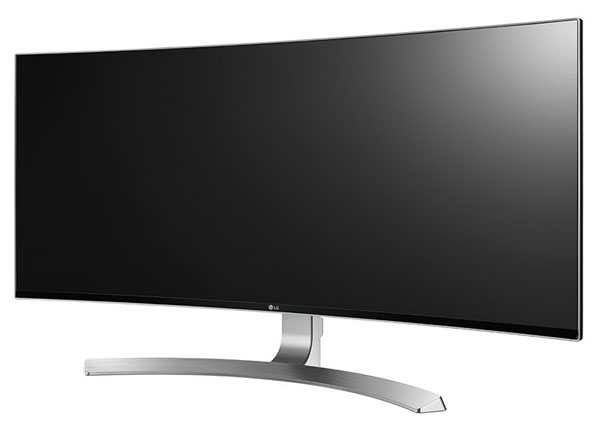Early Verdict
Even though the prices of curved monitors are still $1000 and up, we like the category enough to keep covering it. And obviously people are buying them or we wouldn't see new models continue to appear. Like it or not, the curve seems here to stay and we're glad to see manufacturers putting greater effort into quality. The 34UC98 is equally at home for gamers and graphics pros alike. While it has a few flaws, it still represents a good choice if you need super-accurate color in your gaming display.
Pros
- +
FreeSync • No calibration necessary • Super-accurate • 1900R curve for immersive gameplay
Cons
- -
Middling contrast • Small 55-75Hz FreeSync range • Merely average input lag • Expensive
Why you can trust Tom's Hardware
Introduction
Despite many reader comments wondering why curved monitors exist, manufacturers have not stopped introducing new models. Even though they've stayed at the premium price level, people are obviously buying them in sufficient quantities to fuel improvements to the technology. What began as a single business-class product two years ago has bloomed into a wide array of choices for both general use and entertainment.

Curved screens are particularly well-suited to gaming where the user seeks greater immersion in the environment. Filling one's peripheral vision with an image goes a long way towards suspension of disbelief and a more involving experience. Newer screens enhance this with a smaller radius curve that brings the monitor's sides in even more.
LG was the first company to show a curved ultra-wide when it introduced the 34UC97 in 2014. We covered it in January of 2015, then went on to review several other similar products, most of which are aimed at gaming and entertainment. LG has now updated that display by adding FreeSync, 75Hz and HDMI 2.0. Today we're looking at the 34UC98.
Specifications
The 34UC98 is a completely new panel part sporting 10-bit color (courtesy of frame-rate conversion), a higher 75Hz refresh rate and AMD FreeSync. The HDMI inputs have been updated to version 2.0 allowing for greater bandwidth and the acceptance of full-resolution 3440x1440 signals. FreeSync however only works over the single DisplayPort 1.2 input.
The main comparison point between FreeSync monitors has become operating range; more specifically, the range of refresh rates within which FreeSync is active. The higher number isn't that important as all the displays we've reviewed provide adaptive-refresh up to their maximums. What potential purchasers want to know is the lower value; the point where frame-tears can occur unless the monitor is equipped with Low Framerate Compensation (LFC).
LFC was implemented in AMD's Crimson driver late last year and it brings relief from frame tears to users who drop below their monitor's FreeSync minimum value; but there's a catch. The monitor must have a sufficiently wide range to take advantage of the feature. The requirement is that the maximum be at least two-and-a-half times the minimum; meaning a 75Hz display needs to support adaptive-refresh down to 30Hz. The 34UC98 only goes to 55Hz and therefore won't allow for LFC.
Of course as always, we'll be taking a look at real-world gaming performance during this review. Is the 55Hz lower limit going to be a problem? Our R9-285 system will tell us. Otherwise, the 34UC98 has some decent cred. Accuracy is obviously a priority given that LG has included a factory calibration with data sheet to match. Its gaming specs may not be earth-shattering but in the accuracy department, we're expecting some good things. But enough talk, let's take a look at the 34UC98.
MORE: Best Computer MonitorsMORE: Display Calibration 101
MORE: The Science Behind Tuning Your Monitor
MORE: All Monitor Content

Christian Eberle is a Contributing Editor for Tom's Hardware US. He's a veteran reviewer of A/V equipment, specializing in monitors. Christian began his obsession with tech when he built his first PC in 1991, a 286 running DOS 3.0 at a blazing 12MHz. In 2006, he undertook training from the Imaging Science Foundation in video calibration and testing and thus started a passion for precise imaging that persists to this day. He is also a professional musician with a degree from the New England Conservatory as a classical bassoonist which he used to good effect as a performer with the West Point Army Band from 1987 to 2013. He enjoys watching movies and listening to high-end audio in his custom-built home theater and can be seen riding trails near his home on a race-ready ICE VTX recumbent trike. Christian enjoys the endless summer in Florida where he lives with his wife and Chihuahua and plays with orchestras around the state.
-
3ogdy Nice article! There is a big problem though. LG is usually and unfortunately selling FALSE and FAKE advertising. They put unrealistic pictures of their products on the Internet, on the product's web page and even on the product's box itself. I see that, despite reviewing this screen you haven't provided a single picture of this product taken in real life (unlike those LG promotes the product with...cough, fooling its customers into believing the image goes from edge to edge only for them to find out there are thick black edges all around the screen, cough) - with the screen turned on.Reply
Given how the screen looks like, I'm sure they keep promoting this "borderless" bullshit. Next time you review LG monitors, PLEASE take pictures of the screen turned on.
They literally mentioned their bezels were 1.2mm thick. Guess what, they are actually...wait for it... about 950% bigger - 11mm wide in reality.
Have a look for yourself at the results -
darth_adversor Price tag seems excessive for such a small FreeSync range.Reply
What happens if you exceed 75 fps (i.e. you have a high-end video card, or you're playing a graphically less demanding game)? Can't screen tearing also occur when your fps exceed the monitor's refresh rate?
I've had my gaming PC hooked up to an HDTV for the past several years, considering going back to an actual monitor.
Currently, I use a program called DXtory to limit my fps to 60, I've found that to be superior to v-sync, AMD's FRTC, and/or just letting the framerate run wild. I wonder if that would also work with a FreeSync monitor.
Anyway, great review! -
Larry Litmanen I have a Dell U3415W, also 1440P, also has speakers and also Widescreen in 34 inches, rated by Toms as one of the best monitors for 2015..................Costs $650 or so.Reply -
3ogdy Reply18044039 said:I have a Dell U3415W, also 1440P, also has speakers and also Widescreen in 34 inches, rated by Toms as one of the best monitors for 2015..................Costs $650 or so.
I subscribe.
I happen to be the owner of a Dell UltraSharp U2515H and the image quality is exquisite. It's 1440p too, although only 25". My next monitors will definitely be Dell. -
photonboy 55Hz to 75Hz Freesync range?Reply
WTF?
So you get the smooth game advantage ONLY if your frame rate is between 55FPS and 75FPS.
That SUCKS.
It means when you go above or below this value you either have VSYNC ON or VSYNC OFF. So you might get screen tearing every type you drop below 55FPS, but hitting 75FPS might force VSYNC ON so suddenly you have some added lag (a bit more sluggish).
*Far better to just NOT have the feature likely.
If they'd done 30Hz to 75Hz Freesync range then the low-end would have at least been fine as you'd be in asynchronous mode any time you are below 75FPS. In fact, you could just set a CAP near 70FPS and stay in asynchronous mode all the time, but nooooo.
Basically they must have SAVED A BIT OF MONEY by not supporting the ideal 2.5X minimum ratio for asynchronous range (75/30) so they could put the FREESYNC stamp on the monitor.
GSYNC might be more expensive but NONE of their monitors have this problem at least. -
photonboy To Darth_Adversor->Reply
Setting a cap of 60FPS would mean the GPU outputs a max of 60FPS and that is VSYNC OFF so you will get screen tearing though it may not be obvious for some games (it varies).
If it is a Freesync monitor and 60FPS is within the asynchronous range then the game should be smooth because the GPU dictates when the monitor updates so you don't get screen tear or added latency.
If it is a Freesync monitor and the range is less than 2.5X (75/30) you have VSYNC ON or VSYNC OFF (but not Freesync) if you drop below the minimum. If the range was 40Hz to 75Hz then any time you are below 40FPS you might get screen tear (or stutter if VSYNC is forced back ON).
If it's a normal 60Hz monitor then you simply limit the frame rate to one that matches the monitor. Since VSYNC is OFF you don't get the added latency of buffering to synchronize with the next refresh cycle (every 1/60th second), however you also aren't synchronizing when the frame updates either so you will get screen tearing. -
rockstar_7 ReplyNice article! There is a big problem though. LG is usually and unfortunately selling FALSE and FAKE advertising. They put unrealistic pictures of their products on the Internet, on the product's web page and even on the product's box itself. I see that, despite reviewing this screen you haven't provided a single picture of this product taken in real life (unlike those LG promotes the product with...cough, fooling its customers into believing the image goes from edge to edge only for them to find out there are thick black edges all around the screen, cough) - with the screen turned on.
Given how the screen looks like, I'm sure they keep promoting this "borderless" bullshit. Next time you review LG monitors, PLEASE take pictures of the screen turned on.Nice article! There is a big problem though. LG is usually and unfortunately selling FALSE and FAKE advertising. They put unrealistic pictures of their products on the Internet, on the product's web page and even on the product's box itself. I see that, despite reviewing this screen you haven't provided a single picture of this product taken in real life (unlike those LG promotes the product with...cough, fooling its customers into believing the image goes from edge to edge only for them to find out there are thick black edges all around the screen, cough) - with the screen turned on.
Given how the screen looks like, I'm sure they keep promoting this "borderless" bullshit. Next time you review LG monitors, PLEASE take pictures of the screen turned on.
If you have the latest AMD drivers, just turn the Auto Scaling on.
This will fix those black bars that you see thanks to your ignorance.
-
awez Just want to mention that i have the LG 29um67 Ultra wide HD freesync screen and man can i tell you guys it opened a whole new immersive world of gaming for me coming from a 16:9 24" screen. Feels like a cinema experience. Also i found it to be very practical for work.Reply
I'll never go back to 16:9 aspect ratios :)